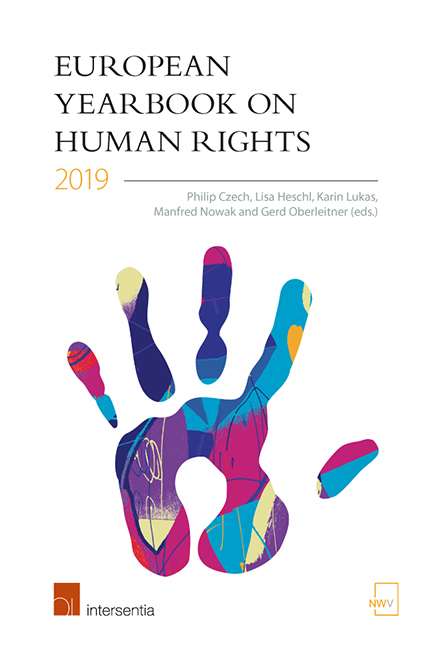Book contents
- Frontmatter
- Miscellaneous Frontmatter
- Editors’ Preface
- Contents
- List of Abbreviations
- List of Contributors
- PART I TOPIC OF THE YEAR
- PART II EU
- PART III CoE
- PART IV OSCE
- PART V REPORTS FROM THE FIELD
- PART VI OTHERS
- PART VII BOOK REVIEWS
- Lisa Heschl: Protecting the Rights of Refugees Beyond European Borders – Establishing Extraterritorial Legal Responsibilities
- Lorenza Violini and Antonia Baraggia (eds.): The Fragmented Landscape of Fundamental Rights Protection in Europe
- Panos Kapotas and Vassilis P. Tzevelekos (eds.): Building Consensus on European Consensus – Judicial Interpretation of Human Rights in Europe and Beyond
- Pieter van Dijk, Fried van Hoof, Arjen van Rijn and Leo Zwaak (eds.): Theory and Practice of the European Convention on Human Rights
- Adrienne Yong: The Rise and Decline of Fundamental Rights in EU Citizenship
- Jeroen Temperman, T. Jeremy Gunn and Malcolm Evans (eds.): The European Court of Human Rights and the Freedom of Religion or Belief – The 25 years since Kokkinakis
- Janneke Gerards: General Principles of the European Convention on Human Rights
- Index
Panos Kapotas and Vassilis P. Tzevelekos (eds.): Building Consensus on European Consensus – Judicial Interpretation of Human Rights in Europe and Beyond
from PART VII - BOOK REVIEWS
Published online by Cambridge University Press: 24 January 2020
- Frontmatter
- Miscellaneous Frontmatter
- Editors’ Preface
- Contents
- List of Abbreviations
- List of Contributors
- PART I TOPIC OF THE YEAR
- PART II EU
- PART III CoE
- PART IV OSCE
- PART V REPORTS FROM THE FIELD
- PART VI OTHERS
- PART VII BOOK REVIEWS
- Lisa Heschl: Protecting the Rights of Refugees Beyond European Borders – Establishing Extraterritorial Legal Responsibilities
- Lorenza Violini and Antonia Baraggia (eds.): The Fragmented Landscape of Fundamental Rights Protection in Europe
- Panos Kapotas and Vassilis P. Tzevelekos (eds.): Building Consensus on European Consensus – Judicial Interpretation of Human Rights in Europe and Beyond
- Pieter van Dijk, Fried van Hoof, Arjen van Rijn and Leo Zwaak (eds.): Theory and Practice of the European Convention on Human Rights
- Adrienne Yong: The Rise and Decline of Fundamental Rights in EU Citizenship
- Jeroen Temperman, T. Jeremy Gunn and Malcolm Evans (eds.): The European Court of Human Rights and the Freedom of Religion or Belief – The 25 years since Kokkinakis
- Janneke Gerards: General Principles of the European Convention on Human Rights
- Index
Summary
The European Convention on Human Rights, as the Court itself reiterated in its case law on so many occasions, is a living instrument that has to be interpreted in light of present-day conditions. One of the interpretative tools and concepts the Court employs in order to identify developments in legislation and administrative practices primarily, but not exclusively, in the Council of Europe Member States is the European Consensus. The concept of European Consensus aims to denote the results of a comparative analysis conducted in order to indicate the level of uniformity present in national legal systems of Member States. In this manner, the Court can effectively fulfil its duty of developing binding human rights standards across Europe.
The book under review, Building Consensus on European Consensus – Judicial Interpretation of Human Rights in Europe and Beyond, focuses on the challenges of conceptualisation of European Consensus – its use, function, and its effects. Quite interestingly, it also compares and contrasts this method of interpretation with similar concepts in other legal systems – not just within Europe but also, as the title itself suggests, beyond.
Edited by devoted human rights researchers, Panos Kapotas of the University of Portsmouth and Vassilis P. Tzevelekos of the University of Liverpool, the book comprises nineteen contributions most of which are selected papers presented at a two-day conference at the European University Institute in Florence. The contributions are grouped into three thematic units. The first examines the definitional framework of European Consensus, its modus operandi, and its effects. However, the contributions do not only focus on the mere definition of the concept but also explore its history, the logic behind its function and the relation to other methods of interpretation employed by the Court, mainly the margin of appreciation doctrine. Building on the theoretical groundwork of the Consensus, the second part focuses on critical evaluation and normative analysis of its legitimacy and its outputs. The third part undertakes a comparative consensus analysis of different types of legal systems.
Interestingly, despite being one of the Court's official methods of interpretation, the European Consensus only recently started to gain more attention. It is common practice that most papers and researches rather focus on the margin of appreciation doctrine, while the European Consensus tends to stay in the background. Regarding its indisputable practical significance for the future progress of human rights standards, it is hard to comprehend this tendency.
- Type
- Chapter
- Information
- European Yearbook on Human Rights 2019 , pp. 573 - 574Publisher: IntersentiaPrint publication year: 2019

